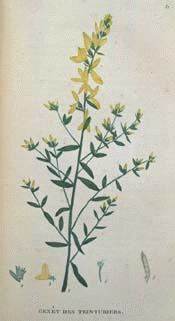

|
Broom, Dyer's
(Genista tinctoria)
|
Broom, Dyer's
Botanical: Genista tinctoria (LINN.)
Family: N.O. Leguminosae
---Synonyms---Dyer's Greenwood. Dyer's Weed. Woad Waxen.
(French) Genêt des Teinturiers.
(German) Färberginster.
---Parts Used---Twigs and leaves.
---Habitat---The Dyer's Broom (Genista tinctoria, Linn.) is a small shrubby plant with narrow, pointed leaves and yellow flowers, growing in meadows, pastures and heaths and on the borders of fields, not uncommon in England but rare in Scotland. It is wild throughout Europe and established on barren hills and on roadsides in the eastern states of North America. It is also cultivated in greenhouses in the United States, on account of its profusion of yellow papilionaceous flowers.
---Description---The bright green smooth stems, 1 to 2 feet high, are much branched; the branches erect, rather stiff, smooth or only lightly hairy and free from spines. The leaves are spear-shaped, placed alternately on the stem, smooth, with uncut margins, 1/2 to 1 inch in length, very smoothly stalked; the margins fringed with hairs.
The shoots terminate in spikes of brightyellow, pea-like flowers, opening in July. They are 1/2 to 3/4 inch long, on foot-stalks shorter than the calyx. Like those of the Broom, they 'explode' when visited by an insect. The 'claws' of the four lower petals are straight at first, but in a high state of tension, so that the moment they are touched, they curl downwards with a sudden action and the flower bursts open. The flowers are followed by smooth pods, 1 to 1/4 inch long, much compressed laterally, brown when ripe, containing five to ten seeds.
A dwarf kind grows in tufts in meadows in the greater part of England and is said to enrich poor soil.
Cows will sometimes eat the plant, and it communicates an unpleasant bitterness to their milk and even to the cheese and butter made from it.
All parts of the plant, but especially the flowering tops, yield a good yellow dye, and from the earliest times have been used by dyers for producing this colour, especially for wool; combined with woad, an excellent green is yielded, the colour being fixed with alum, cream of tartar and sulphate of lime. In some parts of England, the plant used to be collected in large quantities by the poor and sold to the dyers.
Tournefort (1708) describes the process of dyeing linen, woollen, cloth or leather by the use of this plant, which he saw in the island of Samos. It is still applied to the same purpose in some of the Grecian islands. The Romans employed it for dyeing, and it is described by several of their writers.
The plant is called in French Genêt des Teinturiers and in German Färberginster. Its English name in the fourteenth century was Wede-wixin, or Woud-wix, which later became Woad Waxen. We find it also called Green Weed and Dyer's Weed.
It has diuretic, cathartic and emetic properties and both flower tops and seeds have been used medicinally, though it has never been an official drug.
The powdered seeds operate as a mild purgative, and a decoction of the plant has been used medicinally as a remedy in dropsy and is stated to have proved effective in gout and rheumatism, being taken in wineglassful doses three or four times a day.
The ashes form an alkaline salt, which has also been used as a remedy in dropsy and other diseases.
In the fourteenth century it was used, as well as Broom, to make an ointment called Unguentum geneste, 'goud for alle could goutes,' etc. The seed was also used in a plaster for broken limbs.
A decoction of the plant was regarded in the Ukraine as a remedy for hydrophobia, but its virtues in this respect do not seem to rest on very good evidence.
[Top]
Common Name Index
A MODERN HERBAL Home Page
Bear in mind "A Modern Herbal" was written with the conventional wisdom of the early 1900's. This should be taken into account as some of the information may now be considered inaccurate, or not in accordance with modern medicine.
© Copyright Protected 1995-2004 botanical.com

|



